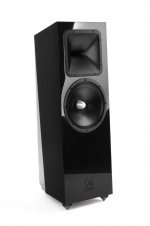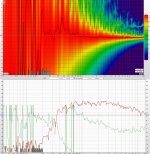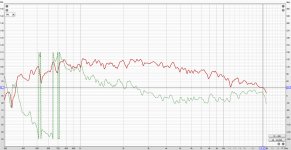I was talking about the compression chamber right at the horn thoat. It is veeeeery difficult to build a small cpompression chamber when loading the back of a driver.
AKA an acoustic low pass filter. 😉 Indeed! Easy enough to seal the basket, but if you need smaller, then a real PIA IME.
I've owned ev hp640 and hp940, then the hr940.
Hp640 has so many reflections, i wouldn't use it for reproduction.
Now for a band pa, absolutely !!!!!!!
In what way do we see the reflections manifest?
Thanks !
It looks as if its vertical radiation was broader than the horizontal radiation at HF. Doesn't it ?
Regards
Charles
Most likely the plots have been swapped by mistake.
I quess the horn has been rotated because at lower frequencies the behaviour is as expected for an MTM with the horizontal radiation angle being larger than the vertical. While it looks the contrary at higher frequencies.
Regards
Charles
Regards
Charles
Don't be surprise, I was looking at the chart for the HP420 and it's obvious whoever took the measurements didn't have the horn dead center, rather, It was pointed slightly to the right....
I quess the horn has been rotated because at lower frequencies the behaviour is as expected for an MTM with the horizontal radiation angle being larger than the vertical. While it looks the contrary at higher frequencies.
Regards
Charles
You're right, I didn't look closely this morning.
I'm not sure which version I've heard by the way, but I'm guessing it was the XR1496 given the setup > 2 point stereo in a wide space.
A prototype of the Ø Audio Icon was tested by Norwegian magazine Stereo with the XR1496 rotated.
Comment of the manufacturer:
The speaker that was tested is the latest prototype that was produced and we have tested with the horn both ways sometimes to see how it turns out. The result is a bit room-dependent whether you hear a particular difference or not.
...but it is incorrectly mounted on the latest studio photos. We had pictures taken at a photo studio in Poland and the horns / wg on the speakers that were sent for the photo were incorrectly mounted. Horn / wg will be the "right" way (rotated 90 degrees, the gap in the middle going vertically) on all speakers that leave us.
And:
Acoustic Elegance makes the woofer. We have developed the driver according to our own spec adapted for use in slightly smaller bass reflex boxes and with a slightly longer linear stroke than the standard version.
Comment of the manufacturer:
The speaker that was tested is the latest prototype that was produced and we have tested with the horn both ways sometimes to see how it turns out. The result is a bit room-dependent whether you hear a particular difference or not.
...but it is incorrectly mounted on the latest studio photos. We had pictures taken at a photo studio in Poland and the horns / wg on the speakers that were sent for the photo were incorrectly mounted. Horn / wg will be the "right" way (rotated 90 degrees, the gap in the middle going vertically) on all speakers that leave us.
And:
Acoustic Elegance makes the woofer. We have developed the driver according to our own spec adapted for use in slightly smaller bass reflex boxes and with a slightly longer linear stroke than the standard version.
Attachments
Last edited:
I am having a hard time figuring out this Amplifier business....Maybe my friends here can help...
I am trying to get power figured out...I think class A is the way to go for the Axi2050...sensitivity is 110db on the elliptical tractrix...I've been entertaining the DIY Tiny Tube. Any suggestions?
I am trying to get power figured out...I think class A is the way to go for the Axi2050...sensitivity is 110db on the elliptical tractrix...I've been entertaining the DIY Tiny Tube. Any suggestions?
Hello camplo
Are you doing any frequency compensation that in not all negative?? An example where it's all negative is say a passive crossover. If you go active and add a +3 here or a plus +6 there just remember it's eating headroom so you may need more power than you think.
Rob🙂
Are you doing any frequency compensation that in not all negative?? An example where it's all negative is say a passive crossover. If you go active and add a +3 here or a plus +6 there just remember it's eating headroom so you may need more power than you think.
Rob🙂
I believe in subtractive eqing first....the first filter will likely be a shelf that is approximately -10db....that gets me to +/- 2.5db (back when I was taking measurements at the mouth that is) but you bring up a good point....after the reduction, sensitivity is likely 88db? And I'll need more watts to get to where I am aiming for (~115db 1m)....
(thanks for the nudge towards clarity Robh)
(thanks for the nudge towards clarity Robh)
Attachments
Last edited:
With active setup, unless you're always listening to white noise, an amp that can handle 110-115dB speaker will be fine, but expect to see higher THD at higher frequency when you measure amp/speaker with sine wave sweep.
Last edited:
when you say "amp that can handle 110-115db"....are we going off of 110db sensitivity or 90db sensitivity...Since I planned to use subtractive eq that resulting sensitivity will be 90db. Maybe that is not how to do it?
at 90db sensitivity something around 130 watts will get me in the above spl range if my math is correct.
If I use additive eq, then I'd be pushing the input signal and raising the noise floor in those areas creating THD at higher frequency like you say but lowering amp power needs
at 90db sensitivity something around 130 watts will get me in the above spl range if my math is correct.
If I use additive eq, then I'd be pushing the input signal and raising the noise floor in those areas creating THD at higher frequency like you say but lowering amp power needs
Last edited:
Since I planned to use subtractive eq that resulting sensitivity will be 90db. Maybe that is not how to do it?
Hello Camplo
FWIR that's the way I would do it and then you add then factor in listening distance which will of course increase the power needed. There are plenty of online calculators for this. Just doing a quick calc 100 watts is 20 db. That would get you 110 from 1 watt 1 meter.
You could do a combination of +/_ EQ to get you a higher base sensitivity but because of the + EQ you power requirements are not likely to change very much. There really is no free lunch.
Rob 🙂
Hello Camplo
Looking at your measurement I think you might be low balling your base sensitivity. You don't need flat on axis out to 20K. What type of horn is it?? CD or non CD looks like a tight pattern CD with the roll off.
If that's a CD horn you are going to want to end up with a tilted in room power response so you might be closer to 95Db or so but you won't know until you power up take some measurements and listening tests.
Rob 🙂
Looking at your measurement I think you might be low balling your base sensitivity. You don't need flat on axis out to 20K. What type of horn is it?? CD or non CD looks like a tight pattern CD with the roll off.
If that's a CD horn you are going to want to end up with a tilted in room power response so you might be closer to 95Db or so but you won't know until you power up take some measurements and listening tests.
Rob 🙂
Last edited:
camplo, I thought you would use active, my bad. This is another thing to be considered when we choose active/passive. If I use digital amp, I may choose passive filter, but with class A amp, 25dB loss at crossover is not trivial.
when you say "amp that can handle 110-115db"....are we going off of 110db sensitivity or 90db sensitivity...Since I planned to use subtractive eq that resulting sensitivity will be 90db. Maybe that is not how to do it?
at 90db sensitivity something around 130 watts will get me in the above spl range if my math is correct.
If I use additive eq, then I'd be pushing the input signal and raising the noise floor in those areas creating THD at higher frequency like you say but lowering amp power needs
Assuming you are using EQ to flatten response across the passband....
once that is accomplished, whether you use additive or subtractive EQ will not matter to sensitivity, or amp power needs, or THD, etc........
when comparing the two approaches at same SPL output of the driver/speaker.
Knowing neither approach matters to the realities imposed on either the amp or the driver, i tend to EQ both up and down from what appears to be a midline sensitivity (from eyeballing the raw response curve).
That midline sensitivity fulcrum is usually pretty close to measured sensitivity of the integrated flattened passband.
I thought subtractive EQ means passive EQ.
You may need 20dB more gain at preamp stage, but an amp that can handle 110dB will handle this speaker because the peak level of actual "music" signal @1K is usually 20dB or more higher than the peak @20K.
I would just add +20dB@20K with digital EQ and it should not be overloaded when I play "music".
You may need 20dB more gain at preamp stage, but an amp that can handle 110dB will handle this speaker because the peak level of actual "music" signal @1K is usually 20dB or more higher than the peak @20K.
I would just add +20dB@20K with digital EQ and it should not be overloaded when I play "music".
Last edited:
- Home
- Loudspeakers
- Multi-Way
- Is it possible to cover the whole spectrum, high SPL, low distortion with a 2-way?


